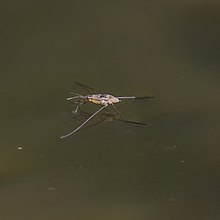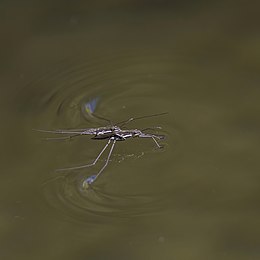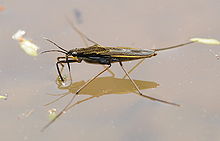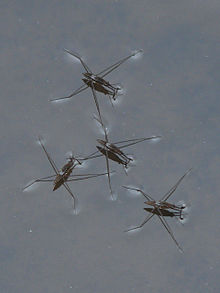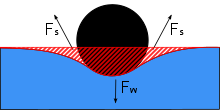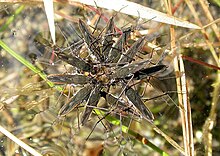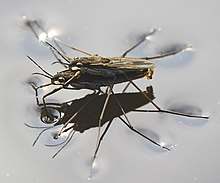
Damselflies are flying insects of the suborder Zygoptera in the order Odonata. They are similar to dragonflies but are usually smaller and have slimmer bodies. Most species fold the wings along the body when at rest, unlike dragonflies which hold the wings flat and away from the body. Damselflies have existed since the Late Jurassic, and are found on every continent except Antarctica.

Hemiptera is an order of insects, commonly called true bugs, comprising over 80,000 species within groups such as the cicadas, aphids, planthoppers, leafhoppers, assassin bugs, bed bugs, and shield bugs. They range in size from 1 mm (0.04 in) to around 15 cm (6 in), and share a common arrangement of piercing-sucking mouthparts. The name "true bugs" is often limited to the suborder Heteroptera.
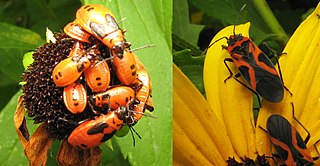
Hemimetabolism or hemimetaboly, also called partial metamorphosis and paurometabolism, is the mode of development of certain insects that includes three distinct stages: the egg, nymph, and the adult stage, or imago. These groups go through gradual changes; there is no pupal stage. The nymph often has a thin exoskeleton and resembles the adult stage but lacks wings and functional reproductive organs. The hemimetabolous insects differ from ametabolous taxa in that the one and only adult instar undergoes no further moulting.
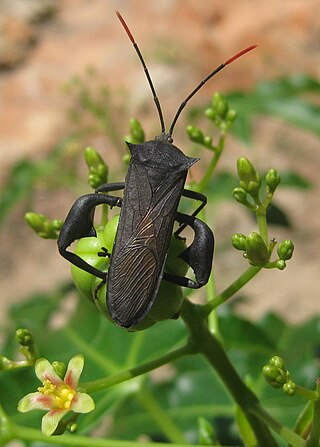
Coreidae is a large family of predominantly sap-sucking insects in the Hemipteran suborder Heteroptera. The name "Coreidae" derives from the genus Coreus, which derives from the Ancient Greek κόρις (kóris) meaning bedbug.

Veliidae is a family of gregarious predatory insects in the suborder Heteroptera. They are commonly known as riffle bugs, small water striders, or broad-shouldered water striders because the segment immediately behind the head is wider than the rest of the abdomen. Species of the genus Rhagovelia are also referred to as ripple bugs.

Nepidae is a family of exclusively aquatic Heteropteran insects in the order Hemiptera. They are commonly called water scorpions for their superficial resemblance to scorpions, due to their raptorial forelegs and the presence of a long slender process at the posterior end of the abdomen, resembling a tail. There are 14 genera in the family, in two subfamilies, Nepinae and Ranatrinae. Members of the genus Ranatra, the most widespread and species-rich genus, are sometimes called needle bugs or water stick insects as they are slenderer than Nepa.

Belostomatidae is a family of freshwater hemipteran insects known as giant water bugs or colloquially as toe-biters, Indian toe-biters, electric-light bugs, alligator ticks, or alligator fleas. They are the largest insects in the order Hemiptera. There are about 170 species found in freshwater habitats worldwide, with more than 110 in the Neotropics, more than 20 in Africa, almost as many in the Nearctic, and far fewer elsewhere. These predators are typically encountered in freshwater ponds, marshes and slow-flowing streams. Most species are at least 2 cm (0.8 in) long, although smaller species, down to 0.9 cm (0.35 in), also exist. The largest are members of the genus Lethocerus, which can exceed 12 cm (4.5 in) and nearly reach the length of some of the largest beetles in the world. Giant water bugs are a popular food in parts of Asia.

The Gerromorpha comprise an infraorder of insects in the "true bug" order Hemiptera. These "typical" bugs are commonly called semiaquatic bugs or shore-inhabiting bugs. The Ochteroidea (infraorder Nepomorpha are also found in shore habitat, while the Gerromorpha are actually most often encountered running around on the water surface, being kept from sinking by surface tension and their water-repellent legs. Well-known members of the Gerromorpha are the namesake Gerridae.

Halobates or sea skaters are a genus with over 40 species of water striders. Most Halobates species are coastal and typically found in sheltered marine habitats, but five live on the surface of the open ocean and only occur near the coast when storms blow them ashore. These are the only known truly oceanic, offshore insects. They are found in tropical and subtropical marine habitats around the world, with a single species recorded in rivers a few kilometers upstream from the ocean. Halobates are generally very common.

Gerris lacustris, commonly known as the common pond skater or common water strider, is a species of water strider, found across Europe.

The six-spotted fishing spider is an arachnid from the nursery web spider family Pisauridae. This species is from the genus Dolomedes, or the fishing spiders. Found in wetland habitats throughout North America, these spiders are usually seen scampering along the surface of ponds and other bodies of water. They are also referred to as dock spiders because they can sometimes be witnessed quickly vanishing through the cracks of boat docks. D. triton gets its scientific name from the Greek mythological god Triton, who is the messenger of the big sea and the son of Poseidon.

Aquarius remigis, known as the common water strider, is a species of aquatic bug. It was formerly known as Gerris remigis, but the subgenus Aquarius was elevated to generic rank in 1990 on the basis of phylogenetic analysis. Aquarius remigis is found throughout North America, but is most prevalent in the mid-west of the United States.
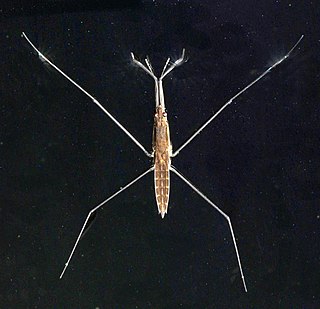
Aquarius najas, also known as the river skater, is a European species of water strider. It was formerly known as Gerris najas, but the subgenus Aquarius was elevated to generic rank in 1990 on the basis of phylogenetic analysis.
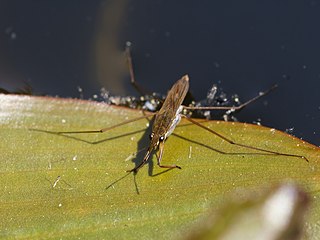
Gerrinae is a subfamily of water strider. This subfamily includes the largest and most best-known group of Gerridae. They are also a phylogenetic subfamily made up of two tribes, and ~14 genera.

Notonecta undulata, also known by the common name grousewinged backswimmer, are from the family Notonectidae and the insect suborder Heteroptera. They are a type of hemipteran or true bug. These aquatic insects typically spend their time at the water's surface, using their abdomen and legs to cling to the underside of the surface tension. The Grousewinged backswimmer can be found in both lotic and lentic environments; however, they typically prefer small ponds and lakes where the water is slow-moving with less current. They swim upside down looking for prey. Once they stop swimming they float back up to the surface. These insects can be distinguished from water boatman or Corixidae by their segmented beak and front legs. Water boatman have highly modified front legs whereas backswimmers do not. Backswimmers are distributed across a broad range throughout North America. However, the species Notonecta undulata has only been documented and studied in southern Manitoba, Saskatchewan, Alberta and the western United States. N. undulata differs from other backswimmers by their antennae and size. They are approximately 10–12 mm long, and their antennae are 4 segmented.

Aquarius conformis is a species of water strider in the family Gerridae. It is found in eastern North America from Quebec west to Wisconsin and south to Florida and Mexico.
Gerris buenoi is a species of water strider that belongs to the family Gerridae. It was first identified in 1911 and is native to continental USA and Canada. Individuals of this species are small in size and have modified appendages, allowing them to float and "skate" along the surface of the water. G. buenoi can be found near the shoreline of freshwater ponds and small lakes, where they hunt for terrestrial insects that have fallen into the water.

Halobates micans is a species of water strider in the family Gerridae. It is one of five Halobates species that live on the surface of the open ocean, only occurring near the coast when storms blow them ashore. Unlike the others that are restricted to the Indian and/or Pacific Oceans, H. micans is circumglobal, occurring offshore in warmer seas around the world. It is the only Halobates species found in the Atlantic Ocean where it ranges from about 40° north to 40° south.
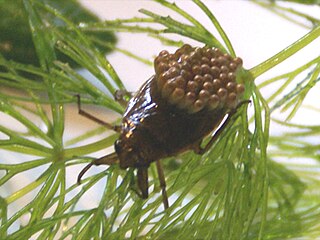
Appasus japonicus is a species of giant water bug in the family Belostomatidae. It is found in Japan and Korea, and has been much studied because it provides an example, rare among insects, of paternal care of the young. With the destruction of its typical habitat and its poor dispersal abilities, it has been listed as being an endangered species in Japan.

Hermatobates is a genus of wingless marine bugs placed as the sole genus in the family Hermatobatidae that are sometimes known as coral-treaders. They are quite rare and known only from coral reefs in the Indo-Pacific region. During low tide, they move over the water surface not unlike the more familiar water-striders around coral atolls and reefs and stay submerged in reef crevices during high tide.
